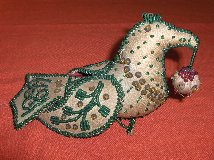The Mi’kmaq
The Micmacs of eastern Canada and the northeastern corner of the United States (who prefer the phonetic spelling Mi’kmaq) first appeared in their homeland approximately ten thousand years ago. They call the region Mi’kma’ki. Archaeological evidence indicates that these first inhabitants arrived from the west and lived as hunters and gatherers attuned to the shifting, seasonal resources of the area. During the summer months they hunted and fished, sometimes venturing out to sea to hunt whales and porpoises. Their winter camps were inland, built along rivers and lakes so that they could augment their hunting by spearing and trapping eels and other water creatures.

The tribal territory included all of what is now Nova Scotia and Prince Edward Island, the Gaspé Peninsula of Quebec, the north shore of New Brunswick and inland to the Saint John River watershed, eastern Maine, and part of Newfoundland, including the islands in the Gulf of Saint Lawrence as well as St. Pierre and Miquelon. The Micmacs’ neighbors recognized their territory and rarely violated its borders. Micmac people thought of their homeland as containing seven districts: Kespukwitk, Sikepne’katik, Eski’kewaq, Unama’kik, Piktuk aqq Epekwitk, Sikniktewaq, and Kespe’kewaq. A keptan orsaqmaw (district chief) presided in each jurisdiction, doubling as local ruler and delegate to the Grand Council Sante’ Mawiomi.
The Grand Council was the governing body of the nation and was led by several officers, including a kji’saqmaw(grand chief), a putus (treaty holder and counselor), and a kji’keptan (grand captain, advisor on political affairs). The Sante Mawiomi determined where families might hunt, fish, and set up their wumitki (camp). More importantly, the Grand Council managed relations with other aboriginal nations. The Micmacs were members of the Wabanaki Confederacy, a loose coalition that included the Maliseets, the Pasamaquoddy, the Penobscots, and the Eastern and Western Abenakis of present-day Maine, New Hampshire, and Vermont. At its peak, this confederacy influenced tribal life from the Gaspé Peninsula to northern New England.
 The Micmacs’ first contact with Europeans did not surprise them or alter their worldview. A legend in which one of their spiritual beings traveled across the Atlantic to “discover” Europe taught that blue-eyed people would arrive from the east to disrupt their lives. Micmac people also knew the story of a woman who had a vision of an island floating toward their lands; the island was decked out with tall trees on which were living beings. Thus the Micmacs were not startled by the appearance of early explorers in sailing ships. Instead, they greeted the newcomers, set up a brisk trade with them, and looked forward to incorporating the strangers’ new technologies into their own culture.
The Micmacs’ first contact with Europeans did not surprise them or alter their worldview. A legend in which one of their spiritual beings traveled across the Atlantic to “discover” Europe taught that blue-eyed people would arrive from the east to disrupt their lives. Micmac people also knew the story of a woman who had a vision of an island floating toward their lands; the island was decked out with tall trees on which were living beings. Thus the Micmacs were not startled by the appearance of early explorers in sailing ships. Instead, they greeted the newcomers, set up a brisk trade with them, and looked forward to incorporating the strangers’ new technologies into their own culture.
Relations with outsiders grew more complex when the Micmacs began converting to Catholicism. This process occurred over a seventy-year period, beginning with the conversion of Grand Chief Membertou in 1610. The Micmac Nation’s first treaty with a European nation was an agreement with the Vatican and the Holy See. This treaty was symbolized by a wampum belt at whose center stood a black-robed priest, a cross, and a Micmac figure holding a pouch, representing the incorporation of Micmac spirituality within the context of Roman Catholicism. In the eighteenth century, the Micmacs established a series of treaties with the British Crown that gave Britain an alliance with the Wabanaki Confederacy and security across the region. During this era, the Micmacs adopted the eight-pointed star as a representation of their part of this alliance. Seven of the points represented the seven districts of Mi’kma’ki, with the eighth point standing for Great Britain and the Crown.
 The first of the series of treaties between the British Crown and the Micmac Nation was signed in 1725. All were reaffirmed in 1752, and culminated in the Treaty and Royal Proclamation of 1763. The main thrust of these treaties was an exchange of Micmac loyalty for a guarantee that Micmacs would be able to continue hunting and fishing in their territory. These treaties have been recognized by the Supreme Court of Canada as legal and binding through its decisions in cases that have extended well into the present century.
The first of the series of treaties between the British Crown and the Micmac Nation was signed in 1725. All were reaffirmed in 1752, and culminated in the Treaty and Royal Proclamation of 1763. The main thrust of these treaties was an exchange of Micmac loyalty for a guarantee that Micmacs would be able to continue hunting and fishing in their territory. These treaties have been recognized by the Supreme Court of Canada as legal and binding through its decisions in cases that have extended well into the present century.
The Grand Council of the Micmac Nation has survived the passage of time, and its officers now have both secular and religious duties. Because of the nature of the Micmac homeland, the Grand Council’s jurisdiction is international. The First Nation communities (reservations) of Canada are governed by an elected chief and council, who hold office for two years. Under the terms of a 1959 act of the Canadian Parliament, all aboriginal people of Canada are Canadian citizens and have the right to vote in federal and provincial elections.
The Micmac language is part of the Algonquian language family, and its ancestral language is Proto-Algonquian. Early forms of communication among the Micmacs included an elaborate system of runners who went from village to village relaying messages about recent or future events, treaties entered into, and even calls to war.
The earliest written language was a hieroglyphics on birchbark or animal hides. Father La Clerq, a French missionary priest, noticed children using this system as a memory aid and adapted it to translate scriptures in 1691. Silas T. Rand wrote out the sounds as he heard them spoken using the modern-day alphabet. He used his work to translate scripture as well as ordinary communication into the Micmac language and published a forty thousand -word grammar in 1894. A new orthography was developed in 1974 to give a more accurate representation of the sounds of the Micmac language. There are eleven consonants in Micmac – p. t, k, q, j, s, l, m, n, w, and y. And there are six vowels – a, e, i, o, and u, along with their corresponding long sounds, and schwa, denoted by a barred i.
Micmac is a polysynthetic, non-gender-specific, verb-oriented language with approximately seventy-five hundred native speakers in the Micmac Nation. Recently there has been renewed interest in the language, and it is being introduced into the reservation schools as part of the curriculum. In addition to the language, Micmacs have also focused on waltes, a traditional Micmac game. Waltes was believed by Euro-Americans to be a heathen gambling game that promoted infidelity, promiscuity, and gambling. Indian agents and the clergy tried to stop it for decades, but it has survived as an important element in traditional tribal life. In addition, modern Micmac society has retained some of its skills in crafts such as basket making, working with hides, and using beads or quills on birch bark and hides.
The Micmac population is approximately twenty thousand, with one-third able to speak and/or write in Micmac. Unemployment is the major problem on the modern reservations. More and more Micmacs are educating themselves, with the schools incorporating the language and culture into their curricula. There is also a concentrated effort to incorporate Micmac history into the general history of the region as taught in the Nova Scotia schools. The Nova Scotia government has designated the month of October as Micmac History Month. Unfortunately, such gains are often undermined by the lack of adequate employment for young, educated tribal members. Nevertheless, Micmac elders are adamant in their belief that the key to tribal survival is the maintenance of the group’s language, culture, and traditions.
Johnson, Eleanor, “Mi’kmaq Tribal Consciousness in the Twentieth Century” in Paqtatek, ed. Stephanie Inglis and Joy Manette (Halifax, Nova Scotia:Garamound Press, 1990); Knockwood, Isabelle, Out of the Depths (Lockport, Nova Scotia: Roseway Publishing, 1992.
By Patrick Johnson, Cape Breton University, Sydney, N.S. writing in The Encyclopedia of North American Indians, 1996, Houghton Mifflin Company, New York, Frederick E. Hoxie, ed. pp.376-378.
